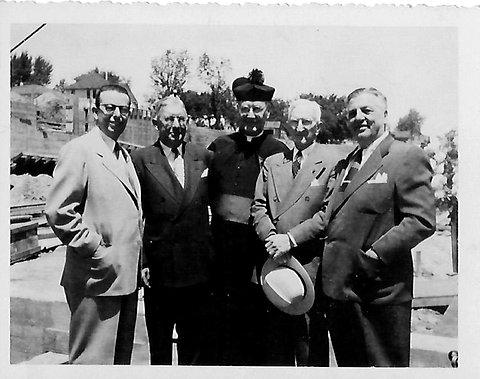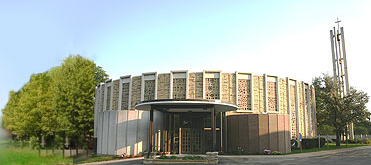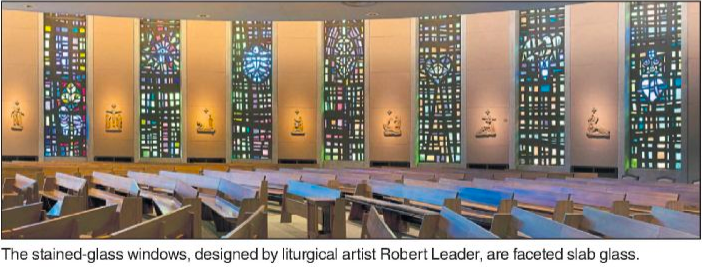Encyclopedia Dubuque
"Encyclopedia Dubuque is the online authority for all things Dubuque, written by the people who know the city best.”
Marshall Cohen—researcher and producer, CNN
Affiliated with the Local History Network of the State Historical Society of Iowa, and the Iowa Museum Association.
ST. JOSEPH THE WORKER CATHOLIC CHURCH: Difference between revisions
No edit summary |
No edit summary |
||
| (8 intermediate revisions by the same user not shown) | |||
| Line 1: | Line 1: | ||
[[File:stjw. | [[File:stjw.png|300px|thumb|left|]]ST. JOSEPH THE WORKER CATHOLIC CHURCH. Serving the tenth Catholic parish in Dubuque, St. Joseph's parish officially came into being with the installation of Msgr. Michael J. Martin on December 4, 1949, at Washington Junior High School (later [[WASHINGTON MIDDLE SCHOOL]]). Archbishop [[ROHLMAN, Henry P.|Henry P. ROHLMAN]] officiated at the ceremony. Msgr. Martin's temporary parish church was established at the Mercy Hospital chapel with Masses conducted at Washington Junior High. (1) | ||
The site for | The site for St. Joseph, at 60 South Algona, was blessed on December 11, 1949. Work on the school began in the spring of 1950 with Archbishop Henry P. Rohlman officiating at the laying of the cornerstone on June 8th. A temporary church, capable of seating six hundred people, was built and later converted into an auditorium and gymnasium when the church was constructed. (2) | ||
Construction on the new church began with groundbreaking ceremonies on October 4, 1967. The new circular church was constructed of native limestone with faceted glass windows. Stations of the cross were hand carved from linden wood brought from northern Italy. An exterior carving of St. Joseph the Workman and the stone altar table were created from Farley limestone. | [[File:St Joes comm.jpg|300px|thumb|left|Building Committee of the church: Frank Oromon, Graham ?, Monsignor Martin, Bill Clemons, [[PAGE, Karl|Karl PAGE]]. Photo courtesy: Catherine Page]]The church was designed by W. Wayne Smith, an architect from Winona, Minnesota, who had designed and supervised the construction of an estimated one hundred churches in the upper Midwest. (3) Construction on the new church began with groundbreaking ceremonies on October 4, 1967. The new circular church was constructed of native limestone with faceted glass windows. Stations of the cross were hand carved from linden wood brought from northern Italy. An exterior carving of St. Joseph the Workman and the stone altar table were created from Farley limestone. (4) | ||
Professor Robert Leader of the University of Notre Dame designed thirty stained glass windows to completely surround the church. Eight of the windows depict the Beatitudes, eight are abstract in design and offer a background for the sanctuary area, seven show the Passion, six depict Joseph and one is dedicated to vocations. On December 8,1968, the Most Reverend [[BYRNE, James J.|James J. BYRNE]], Archbishop of Dubuque, officiated at the dedication and offered a con-celebrated High Mass in the new church. | [[File:sjtw.png|400px|thumb|left|Photo courtesy: Telegraph Herald]]Professor Robert Leader of the University of Notre Dame was instrumental in the creation of the stained glass windows. Born in Massachusetts, he came to Dubuque in the early 1950s to teach art at [[CLARKE COLLEGE]]. He also served as president of the [[DUBUQUE ART ASSOCIATION]]. Although he left Dubuque in 1953 for the University of Notre Dame, he was contacted by the church building committee to design the stained glass windows. (5) He designed thirty stained glass windows to completely surround the church. Eight of the windows depict the Beatitudes, eight are abstract in design and offer a background for the sanctuary area, seven show the Passion, six depict Joseph and one is dedicated to vocations. (6) On December 8, 1968, the Most Reverend [[BYRNE, James J.|James J. BYRNE]], Archbishop of Dubuque, officiated at the dedication and offered a con-celebrated High Mass in the new church. (7) | ||
The 1987 ''Dubuque City Directory'' listed 90 S. Algona. | By 1993 St. Joseph, located off Dodge Street, was so often confused with St. Joseph in Key West, Rickardsville, and Farley that a name change was suggested. With the approval of the [[ARCHDIOCESE OF DUBUQUE]] and a change in the articles of incorporation, the new name was meant to honor the dignity of labor and the role of work in a Christian's life. | ||
The 1987 '''Dubuque City Directory''' listed 90 S. Algona. | |||
The 1993 '''Dubuque City Directory''' listed 2105 St. Joseph Street. | |||
The address in 2014 was 2001 St. Joseph Street. | |||
--- | |||
Source: | |||
1. Jerde, Lyn Hanson. "New Name," ''Telegraph Herald'', September 27, 1993, p. 3A | |||
2. Ibid. | |||
3. Hogstrom, Erik. "Circular Church Took Shape 50 Years Ago," ''Telegraph Herald,'' April 19, 2018, p. 5A | |||
4. Ibid. | |||
5. London, Michelle. "'Like Wrestling a Thunderbolt,'" ''Telegraph Herald'', March 11, 2023, p. 7 | |||
6. Hogstrom | |||
7. Ibid. | |||
[[Category: Church]] | [[Category: Church]] | ||
Latest revision as of 01:11, 28 November 2024
ST. JOSEPH THE WORKER CATHOLIC CHURCH. Serving the tenth Catholic parish in Dubuque, St. Joseph's parish officially came into being with the installation of Msgr. Michael J. Martin on December 4, 1949, at Washington Junior High School (later WASHINGTON MIDDLE SCHOOL). Archbishop Henry P. ROHLMAN officiated at the ceremony. Msgr. Martin's temporary parish church was established at the Mercy Hospital chapel with Masses conducted at Washington Junior High. (1)
The site for St. Joseph, at 60 South Algona, was blessed on December 11, 1949. Work on the school began in the spring of 1950 with Archbishop Henry P. Rohlman officiating at the laying of the cornerstone on June 8th. A temporary church, capable of seating six hundred people, was built and later converted into an auditorium and gymnasium when the church was constructed. (2)

The church was designed by W. Wayne Smith, an architect from Winona, Minnesota, who had designed and supervised the construction of an estimated one hundred churches in the upper Midwest. (3) Construction on the new church began with groundbreaking ceremonies on October 4, 1967. The new circular church was constructed of native limestone with faceted glass windows. Stations of the cross were hand carved from linden wood brought from northern Italy. An exterior carving of St. Joseph the Workman and the stone altar table were created from Farley limestone. (4)
Professor Robert Leader of the University of Notre Dame was instrumental in the creation of the stained glass windows. Born in Massachusetts, he came to Dubuque in the early 1950s to teach art at CLARKE COLLEGE. He also served as president of the DUBUQUE ART ASSOCIATION. Although he left Dubuque in 1953 for the University of Notre Dame, he was contacted by the church building committee to design the stained glass windows. (5) He designed thirty stained glass windows to completely surround the church. Eight of the windows depict the Beatitudes, eight are abstract in design and offer a background for the sanctuary area, seven show the Passion, six depict Joseph and one is dedicated to vocations. (6) On December 8, 1968, the Most Reverend James J. BYRNE, Archbishop of Dubuque, officiated at the dedication and offered a con-celebrated High Mass in the new church. (7)
By 1993 St. Joseph, located off Dodge Street, was so often confused with St. Joseph in Key West, Rickardsville, and Farley that a name change was suggested. With the approval of the ARCHDIOCESE OF DUBUQUE and a change in the articles of incorporation, the new name was meant to honor the dignity of labor and the role of work in a Christian's life.
The 1987 Dubuque City Directory listed 90 S. Algona.
The 1993 Dubuque City Directory listed 2105 St. Joseph Street.
The address in 2014 was 2001 St. Joseph Street.
---
Source:
1. Jerde, Lyn Hanson. "New Name," Telegraph Herald, September 27, 1993, p. 3A
2. Ibid.
3. Hogstrom, Erik. "Circular Church Took Shape 50 Years Ago," Telegraph Herald, April 19, 2018, p. 5A
4. Ibid.
5. London, Michelle. "'Like Wrestling a Thunderbolt,'" Telegraph Herald, March 11, 2023, p. 7
6. Hogstrom
7. Ibid.



